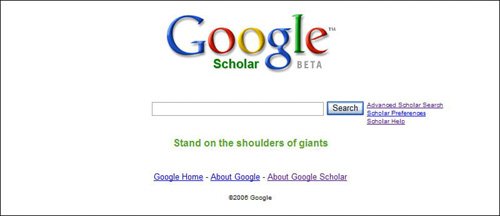How Google Scholar WorksWithin a few short months of its launch, Google Scholar drew raves from its scholarly audience and established itself as a viable (and free) alternative to the expensive research databases offered by Elsevier, Thomson, and other scholarly publishers. While some librarians say that Google Scholar doesn't offer quite the quality and quantity of results of its more established rivals, others praise it for its easy access and simple operation. As you can see in Figure 7.1, the Google Scholar search page closely resembles the traditional Google web search page. You access Google Scholar at scholar.google.com. Figure 7.1. The Google Scholar main search page.
When you search Google Scholar, you receive a list of matching articles, journals, papers, theses, books, and the like, along with a brief summary of each item. Much of the information displayed on the search results page is available online free of charge. Some is available online only for subscribers to a particular service. Some is available online only for members of a particular library. And some is available in printed format only. The information in the Google Scholar database is also available via a traditional Google web search, although it's often buried deep in the search results. The advantage of Google Scholar is that it focuses your search solely on the scholarly literature, and returns results in a format familiar to students and researchers. The search itself is also fine-tuned for the scholarly crowd; you can confine your search to specific disciplines, authors, and publications. Put another way, Google Scholar is a way for students and researchers to find academically appropriate and peer-reviewed literature without having to wade through all the nonprofessional information that clutters the public Internet. Identifying Scholarly ContentTo identify content for inclusion in the Google Scholar database, Google uses an algorithm that guesses at what it thinks is scholarly content. As with Google's PageRank algorithm, the Google Scholar algorithm is a closely guarded secret. What we do know is that the algorithm tries to identify credentialed authors and searches for citations for each article. These citations are extracted and analyzed; at least in part, Google examines the connections between other documents that cite the article in question. This citation analysis is also used to help rank documents within the Google Scholar results. (Google Scholar also takes into consideration the full text of each article, the article's author, and the publication in which the article appeared to make its rankings.) Searching Beyond the Public InternetGoogle Scholar not only searches the public web for scholarly information, it also strives to include articles, journals, and books from major scholarly publishers. If the full text of a document is not available for dissemination via the public web, Google still includes an abstract from the document; you can then choose whether or not to pay for access (if that option is available; some materials require a subscription to the host library for access). Note Another benefit to this citation analysis is a Cited By link next to each search result listing. When you click on this link, you see a list of all pages and documents that point to the current article. Some of this nonpublic information is available by Google's partnering with major scholarly research services and libraries. For example, Google Scholar derives some of its content from the Open WorldCat database, which contains records of materials owned by libraries that participate in the Online Computer Library Center (OCLC) project. (You can learn more about OCLC and Open WorldCat at www.oclc.org.) Note When dealing with scholarly literature, it's often the case that the same paper is hosted in more than one database. In these instances, Google identifies what it believes is the "best" version and provides links to other available versions. Including Print-Only ContentIn the case of some scholarly literature, the publication itself is not actually online; only the abstract and citations are available over the Internet. This is a benefit to including information sourced from various library databasesyou can find out what documents a library has available, even if you can't download them from the Internet. Caution As useful as Google Scholar is, it only searches a fraction of the published scholarly literature. For more comprehensive scholarly research, use the search function provided by your local research library to search the many field-specific databases that cover scholarly publications, such as ABI/Inform, ERIC, Medline, and Proquest. |